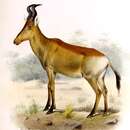Biology
provided by Arkive
A grazing animal, Lichtenstein's hartebeest depends almost exclusively on grasses for food (4). Its long, slender snout may allow it to select better quality leaves from amongst the poorer quality, wiry grasses prevalent in its habitat (7). It may also have digestive adaptations allowing it to get greater benefit from these poorer quality grasses (7). Interestingly, it seems to prefer grasses and vegetation that have been burnt (3). It is strongly dependent on the availability of a surface water source, drinking daily (3), hence its preference for areas of high rainfall and waterlogged ground (3) (7). While some nocturnal feeding does take place, it is mostly active during the cooler periods of the day, in the morning and late afternoon (3) (4).
Herds consist of either non-territorial, bachelor males, or a single, territorial adult male and six or seven adult females along with their offspring (4). The territorial adults occupy an area of around 2.5 square kilometres, usually incorporating better quality grazing and forcing the bachelor herds to inhabit the less suitable grazing areas (4). Territorial males will fiercely defend their territory, with the ensuing fights often leaving the animals wounded, occasionally resulting in death (3).
At 16 to 18 months the females become sexually mature and leave the parent herd to join the herd of a territorial male. Breeding is seasonal, with most births taking place during the dry season around August (3) (7). After a gestation period of 240 days, the calves are born, and at this time, as an anti-predator mechanism, the territorial system may dissolve, leading to much larger herds. As a further protection against predation, births take place at roughly the same time within the herd (3). Interestingly, the mother, while grazing or drinking, makes little attempt to conceal her calf; it is simply bedded down in the open (3).
Conservation
provided by Arkive
While no specific conservation measures exist at the present time, in the 1980s, efforts were made to introduce the species into National Parks in Zimbabwe and South Africa. In Kruger National Park, South Africa over 100 captive-bred animals were released in the period 1990 to 1994. Subsequent monitoring in the period 1995 to 1998 revealed that a population of about 40 individuals still survived there (5). Large, stable populations do exist in parts of Tanzania and Zambia, with populations in these countries recorded during 1998 at over 25,940 and 9,710 respectively (5). One notable conservation success story has been the North Luangwa Conservation Project in Zambia, where strong law enforcement measures managed to help discourage poaching from the North Luangwa National Park, an area which supports a large population of Lichtenstein's hartebeest (5) (8). The future of Lichtenstein's hartebeest would seem positive, so long as protective measures in National Parks and Game Reserves are enforced, so that larger populations remain stable (5).
Description
provided by Arkive
Once the most widespread of all hartebeest, this distinctive antelope was found throughout much of southern Africa (3). Like its relative, the common hartebeest (Alcelaphus buselaphus), Lichtenstein's hartebeest has a long, slender head, elongated, pointed ears, long legs and a reasonably bulky body, with the shoulders set higher than the rump (4). In contrast with the diversity of colouring found between the subspecies of common hartebeest, coat colour varies little between individuals of this species. It is generally a yellow-fawn or pale reddish-fawn, with a darker “saddle” area extending from the base of the tail, across the back to the shoulders (3) (4). The flanks and, in particular, the rump are lighter in colour, while the lower legs are also generally pale except for a black stripe running down the front (2) (4). The horns of Lichtenstein's hartebeest are distinctly ringed, except at the tips, and curve back from the head in an S-shape (3) (4). This species is notable for making an unusual “sneeze-snort” alarm call that serves to warn other herd members of danger (3).
Habitat
provided by Arkive
Lichtenstein's hartebeest inhabits open woodland, preferring short to medium length grass cover and avoiding longer grasses. It favours flatter areas prone to seasonal waterlogging (7).
Range
provided by Arkive
It is likely that populations of Lichtenstein's hartebeest once found stretched from western and southern regions of Tanzania all the way down to northern parts of South Africa (5). Today, however, populations are scattered, with substantial populations only found within Tanzania and Zambia. It is also present in the Democratic Republic of the Congo, Malawi and Mozambique and populations have been reintroduced to Zimbabwe and South Africa (5). The species is sadly extinct in Burundi and Swaziland (6) and, though it is still uncertain, it is likely that it is now also extinct in Angola (5).
Status
provided by Arkive
Classified as Lower Risk /Conservation Dependent (LR/cd) on the IUCN Red List (1).
Threats
provided by Arkive
The main threat to Lichtenstein's hartebeest is uncontrolled hunting for its meat. Along with habitat degradation, this has led to the dramatic decrease in its range and extinction in certain areas, such as Burundi (1) (7). Despite many of the remaining populations of Lichtenstein's hartebeest being found in protected areas, such as Game Reserves and National Parks, poor enforcement of protective measures has meant that in some places poaching remains a significant problem (5).

